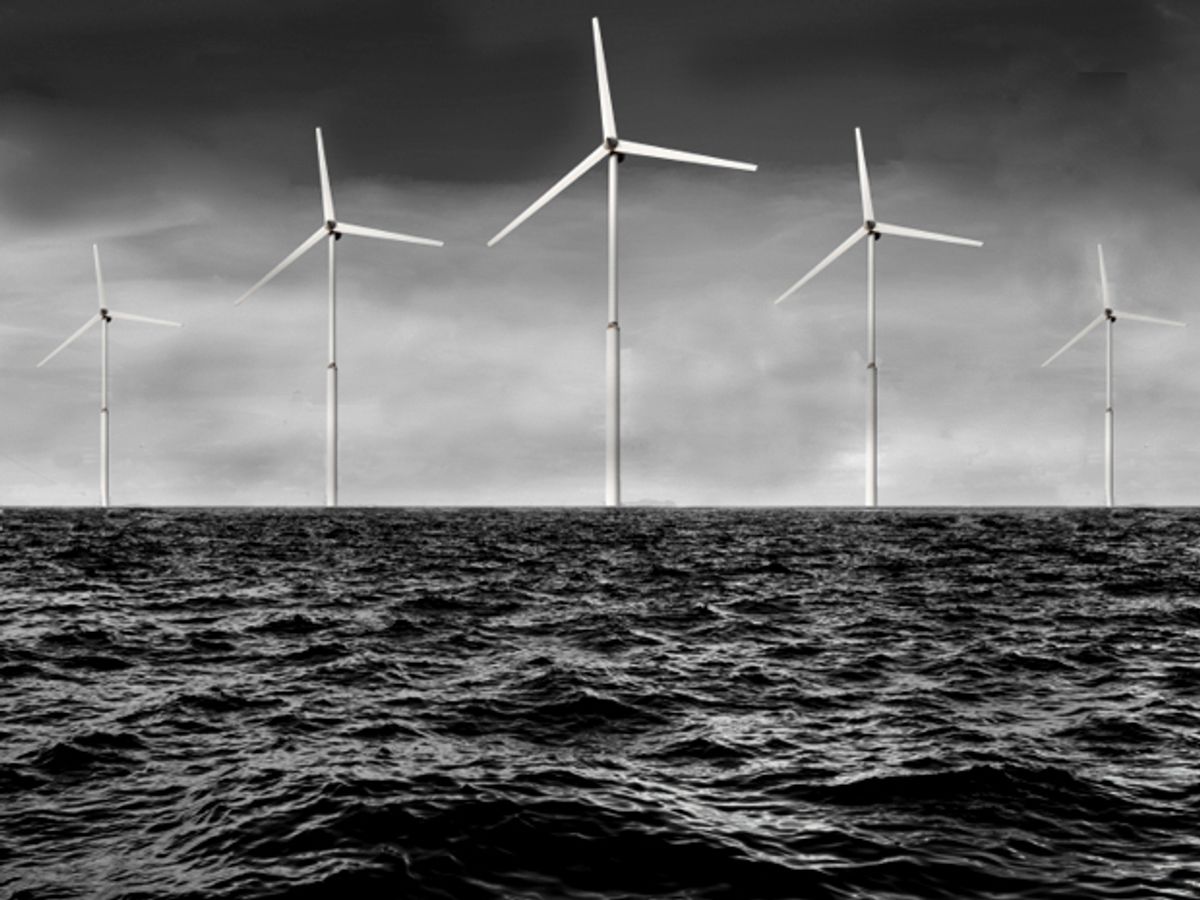What happened when the hurricane ran across thousands of offshore wind turbines? It sounds like a climate scientist's idea of a joke, but a new study has found that offshore wind farms could protect coastal cities by slowing hurricane winds and reducing storm surge.
The spinning turbine blades of offshore wind farms can sap a hurricane's strength by slowing the rotating winds in the outer edge of the rotating storm—an action that leads to smaller waves and eventually slows the wind speeds of the entire hurricane. Simulations have shown that such effects could have significantly dampened the impact of real-life hurricanes Sandy, Isaac and Katrina, according to a new paper detailed in the 26 February 2014 issue of the journal Nature Climate Change.
"We found that when wind turbines are present, they slow down the outer rotation winds of a hurricane," said Mark Jacobson, a professor of civil and environmental engineering at Stanford University, in a news release. "This feeds back to decrease wave height, which reduces movement of air toward the center of the hurricane, increasing the central pressure, which in turn slows the winds of the entire hurricane and dissipates it faster."
Jacobson worked with his colleagues at Stanford and the University of Delaware to simulate hurricane collisions with tens of thousands of offshore wind turbines, based on a computer model that can account for air pollution, energy, weather and climate. They then ran simulations based on the real-life cases of Hurricane Sandy's impact on New York in 2012, Hurricane Isaac's strike on New Orleans in 2012, and Hurricane Katrina's devastating blow on New Orleans in 2005.
In Katrina's case, an array of 78 000 wind turbines off the coast of New Orleans slowed simulated wind speeds by 130 kilometers per hour and decreased storm surge by up to 71 percent. In Isaac's case, the same array of turbines could have decreased peak wind speeds by up to 92 kph and reduced storm surge by up to 60 percent.
Other simulation runs found that even bigger arrays of 272 000 turbines or even 543 000 turbines—located offshore of Cuba and stretching from Florida to Texas—could have dropped Katrina's wind speeds by 158 kph and reduced storm surge by up to 79 percent.
An array of 112 000 turbines stretching from New York City to Washington D.C. could have slowed Sandy's peak winds by 130 kph and decreased storm surge by up to 21 percent. A larger array of 414 000 turbines along most of the U.S. East Coast could have dropped Sandy's wind speeds by almost 141 kph and decreased storm surge by up to 34 percent.
The huge wind farms would do more than just slow down the hurricanes. The largest wind turbine arrays could have extracted up to 2.65 terawatts of peak power from Hurricane Sandy and up to 1.18 terawatts of peak power from Hurricane Katrina—peak power representing the most power extracted at any time during the simulations.
Such simulations suggest that huge wind farms have an edge over traditional coastal city defenses because they slow both wind speeds and decrease storm surge. By comparison, seawalls can only stop storm surge. The cost of building seawalls can also run between $10 billion and $40 billion per installation, whereas expensive wind farms could pay for themselves through energy generation over time.
Hurricane damage to the huge arrays of wind turbines is a risk, Jacobson said. But he pointed out that current wind turbines can stand up to wind speeds of 180 kph within the range of category 2 or 3 hurricanes. And the presence of the huge wind farms could help prevent hurricanes from ever building up to superstorm wind speeds. (The study assumed the wind turbines had a cut-out speed of 180 kph in most of the simulation runs to prevent damage to the turbines.)
Huge arrays of offshore wind turbines remain a far cry from today's reality when the U.S. has yet to build any offshore wind farms. But the new study raises the possibility of hurricane protection as added incentive for building offshore wind farms. Policy planners could consider storm protection as the cherry on top of wind power's known benefits involving renewable power generation, national energy security and the reduction of the human impact on climate change.
Photo: iStockphoto
Jeremy Hsu has been working as a science and technology journalist in New York City since 2008. He has written on subjects as diverse as supercomputing and wearable electronics for IEEE Spectrum. When he’s not trying to wrap his head around the latest quantum computing news for Spectrum, he also contributes to a variety of publications such as Scientific American, Discover, Popular Science, and others. He is a graduate of New York University’s Science, Health & Environmental Reporting Program.



